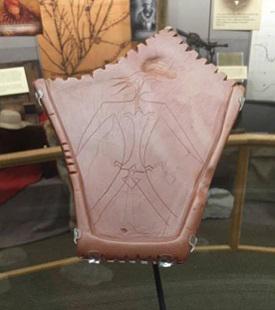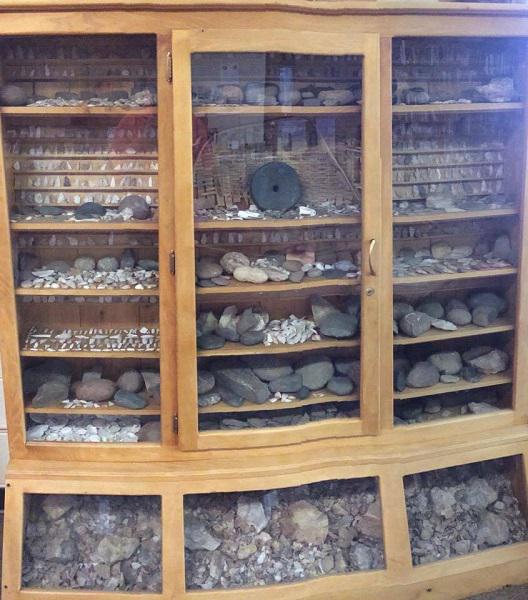updated 03/19/2017
![]()
updated 03/19/2017
More New Albin history ..... Indian Families Mysterious Work of Art - the New Albin Tablet Colsch Artifact collection - New Albin/Sand Cove area |
New Albin Indian Families
Long before New Albin became a town, it was the home of many Indian tribes including Sac, Fox, Sioux and Winnebago. During the Black Hawk War, a fort was built just outside of where the town of New Albin is located today. Indian families later lived in the fort. Two families known to have lived there is the Frank Decorah Family and the Johnny Thompson Family.
click the photos to enlarge them
-source of photos: The First 100 Years
of New Albin
-contributed by Errin Wilker
~*~*~
The New Albin Tablet

A photo of the New Albin Tablet, now exhibited at Effigy Mounds
National Monument.
~from Audrey (Colsch) Berger, photographer & contributor
~*~
MYSTERIOUS WORK OF ART FOUND IN NEW
ALBIN
by Betty Zarwell
The ability to create is what separates humans from all other animals. Long ago, a Native American held a piece of red catlinite (pipestone) in his hands, etched pictures on both sides of the broad, flat surface, and carved notches along its edges. What may have been an attempt to convey some simple or spiritual meaning resulted in the creation of a mysterious work of art. Even more mysterious is why it lay buried in a cache for many, many years. In 1915, this ancient stone tablet was accidentally discovered in New Albin, and today it is on display at Effigy Mounds National Monument Museum near Marquette, IA. It is known as the New Albin Tablet.
Discovery of the tablet
While excavating for a cellar under the New Albin residence of Mr. Gustave "Gus" Welper, (now the Joe Reburn home), one side caved in. When the earth and sand were cleared away, workers discovered a catlinite (pipestone) tablet with pictographs inscribed on both sides of the stone. The workmen estimated that the tablet originally lay at about the three foot level beneath the surface. The tablet was first sold by the man who found it, Mr. Didling, to Mr. R.H. Thompson, who, in turn, sold it to Mr. Harry Orr. According to museum records, Mr. Orr donated the stone tablet in 1960 to Effigy Mounds National Monument, where it remains on display today. A replica of the original catlinite tablet has been cast for study purposes.
Tracing Its origin
Catlinite, or pipestone as it is commonly known, was and is considered to be a spiritual item by members of the Sioux Nation. A soft rock, it was a highly prized trade good and was used for hundreds of years to make ceremonial peace pipes. A quarry in southwest Minnesota, 35 miles north of the Iowa border, has been used as a source of pipestone by Indian craftsmen for centuries. Between 1000 A.D. and about 1800 A.D., most parts of Iowa were inhabited by people of the Oneota culture. The Oneota were known for crafting catlinite into pipes and plaques. Although it is difficult to date the New Albin Tablet, it is reasonable to assume that it was probably created by someone from that period. Because there were no bones, charcoal, pottery, or other material of any kind found with the tablet, the late Ellison Orr, a renowned archeologist from Allamakee County, speculated that it could have been placed there for safekeeping and that its owner perhaps died, or was possibly killed, or driven away by war. Thus, all knowledge of its existence and location was lost.
Long history as Indian site
New Albin, built on an extensive terrace of sand and gravel, is an ideal town site, and obviously appealed to the Indians, as well as his white successors. Copper beads and other trinkets have been found from time to time in the gravel pits at the north end of town. The discovery of burial, lineal, and effigy mounds constructed by Native Americans indicates that they occupied the New Albin area for centuries. In a manuscript written by Orr, he relates two interesting stories to further substantiate this observation.
Many years ago, half a mile southwest of New Albin, Mr. R.H. Thompson dug a hole in which to bury a horse that had dropped dead along the highway. In the process of digging, Thompson found a couple of pairs of arrow shaft smoothers associated with a number of mea ling stones, muliers, celts, etc. - evidence of Indians having inhabited that area. In another instance, a Mr. Hayes settled on some land near New Albin. Located on that property was an Indian burial mound, said to be the grave site of an Indian chief known as Four-eyes. Hayes' daughter, Mrs. Hausman, recalled an old Indian woman once told her about an incident she had witnessed as a child - the burial of a chief at that very site. The Indian woman remembered a hole being dug, and the chief, dressed in his finery, was placed in it astride his dead horse. Earth was then heaped around and over the horse and the man. The event made a lasting impression upon the little Indian girl.
Tablet remains a mystery
Lillian Sires of New Albin remembers her father, the late Gus Welper, telling how the ancient tablet was discovered in the basement of their home. Although her father didn't recall specific details about the tablet itself, Lil was always intrigued by the story. "I'm definitely going to see the tablet," stated Lil upon learning it is now on display at Effigy Mounds. The mystery surrounding the New Albin Tablet may never be unraveled, but the artist who created it has succeeded in stimulating peoples' minds. Who knows - maybe that was the sole intention of this ancient artisan from the very beginning.
-source of article: The
First 100 Years of New Albin
-contributed by Errin Wilker
~*~*~
Ed Colsch's Artifact Collection

Ed Colsch's indian artifact/arrow head collection found on the Sand Cove as well as around the edges of New Albin. The collection was donated and now is at the New Albin Public library.
~from Audrey (Colsch) Berger, photographer
& contributor. Audrey is Ed Colsch's g-niece.
~*~*~